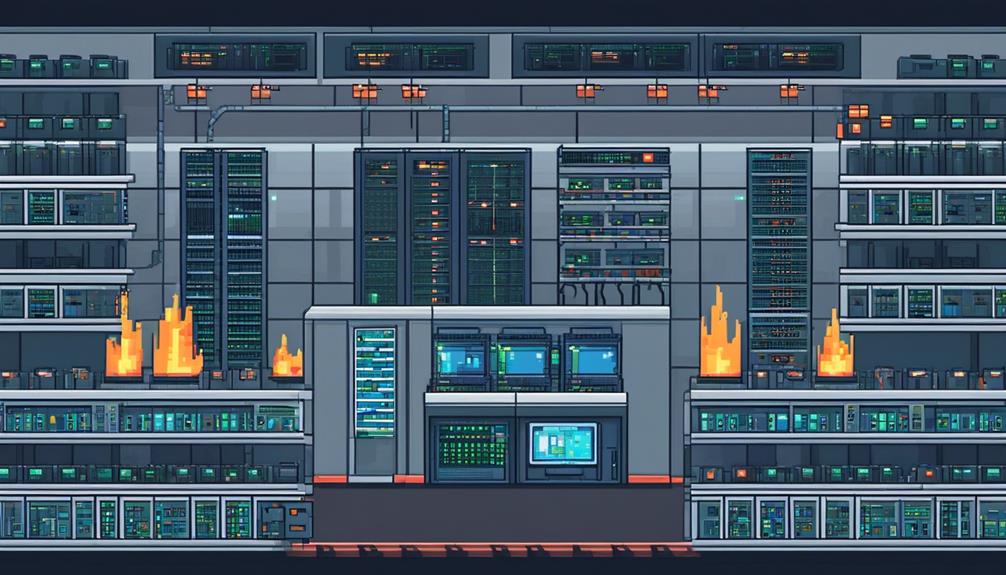Data center security hardware is an integral aspect of maintaining the confidentiality, integrity, and availability of sensitive data housed within these critical facilities. With the ever-increasing threat landscape and the potential for devastating consequences in the event of a breach, organizations must remain vigilant in safeguarding their data centers.
From robust firewalls and intrusion detection systems to access controls and surveillance cameras, the deployment of advanced security hardware solutions plays a pivotal role in thwarting unauthorized access attempts.
This discussion will explore the key components of data center security hardware, highlighting their importance and the benefits they bring to organizations.
Key Takeaways
- Firewalls and intrusion detection systems are essential hardware components for data center security.
- Access control systems, both physical and logical, play a crucial role in limiting unauthorized access to data centers.
- Physical security measures such as perimeter fencing, security guards, and intrusion detection systems enhance the overall security of data center premises.
- Surveillance and monitoring systems, including surveillance cameras and alarm systems, provide continuous monitoring and prompt response to any suspicious activities.
Firewalls
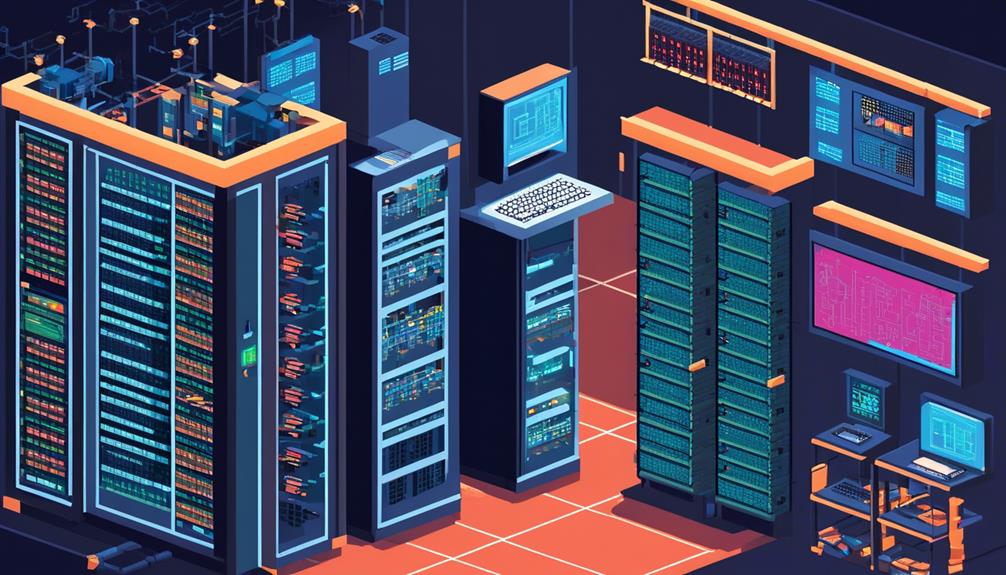
Firewalls are essential security measures used to monitor and control network traffic, protecting data centers from unauthorized access and potential cyber threats. As a critical component of data center security, firewalls serve as a barrier between a trusted internal network and untrusted external networks. They filter incoming and outgoing traffic based on predetermined security rules, ensuring that only authorized data packets are allowed through.
Implementing firewalls as hardware devices, software applications, or a combination of both is crucial to secure data center infrastructure and applications. These firewalls inspect packets of data and determine whether to allow or block them based on predefined security rules. By doing so, they help safeguard the data center from various threats, including malware, viruses, and unauthorized access attempts.
Firewalls play a critical role in enforcing security policies and preventing unauthorized access to sensitive data and resources within the data center. They act as a first line of defense by blocking malicious traffic and preventing it from reaching the internal network. This layer of protection is essential in maintaining the integrity and confidentiality of data stored within the data center.
In conjunction with other security controls and layers of physical security, firewalls contribute to a comprehensive data center security strategy. Physical access controls, such as biometric authentication and surveillance systems, complement the digital security measures provided by firewalls. By combining these measures, data centers can ensure the highest level of protection for their critical assets and maintain smooth data center operations.
Intrusion Detection Systems
Intrusion Detection Systems (IDS) play a crucial role in data center security by monitoring network traffic for potential threats.
One important aspect of IDS is the use of alarm systems, which generate alerts when suspicious activity is detected.
However, integrating IDS into existing network infrastructure can present challenges, as it requires careful configuration and coordination with other security measures to ensure effective detection and response capabilities.
Alarm Systems for IDS
Alarm systems for IDS (Intrusion Detection Systems) provide real-time alerts when unauthorized activities are detected within the data center network, enhancing overall security by proactively notifying potential breaches.
To evoke an emotional response in the audience, consider the following:
- Sub-List 1: Benefits of Alarm Systems for IDS
- Immediate notification of unauthorized access attempts, preventing potential data breaches and minimizing the impact of security incidents.
- Timely detection of unusual network traffic patterns, enabling quick response and mitigation of potential threats.
- Sub-List 2: Importance of Alarm Systems for IDS in Data Center Security
- Essential component of a comprehensive security strategy, working in conjunction with other security measures such as firewalls and access controls.
- Ensures a proactive security posture by providing real-time alerts, enabling prompt incident response and minimizing the risk of data center compromise.
IDS Integration Challenges
Integrating IDS (Intrusion Detection Systems) into complex data center networks poses significant challenges due to the volume of traffic and the need for seamless integration with other security tools and systems. Coordinating IDS deployment across multiple data center locations can present logistical hurdles. Ensuring seamless integration of IDS with other security systems and controls is vital for effective threat detection and response. Fine-tuning IDS configurations to minimize false positives while capturing genuine threats can be a demanding task. Additionally, adapting IDS solutions to evolving network architectures and traffic patterns poses ongoing integration challenges in data center environments. The table below summarizes the key challenges faced when integrating IDS into data center security.
| Challenge | Description |
|---|---|
| Volume of Traffic | Data center networks handle large amounts of network traffic, making it challenging for IDS to analyze all the data effectively. |
| Seamless Integration with Other Tools and Systems | IDS needs to seamlessly integrate with other security tools and systems to ensure comprehensive threat detection and response. |
| Adapting to Evolving Network Architectures | IDS integration must adapt to changing network architectures and traffic patterns to effectively monitor and detect potential intrusions. |
Access Control Systems
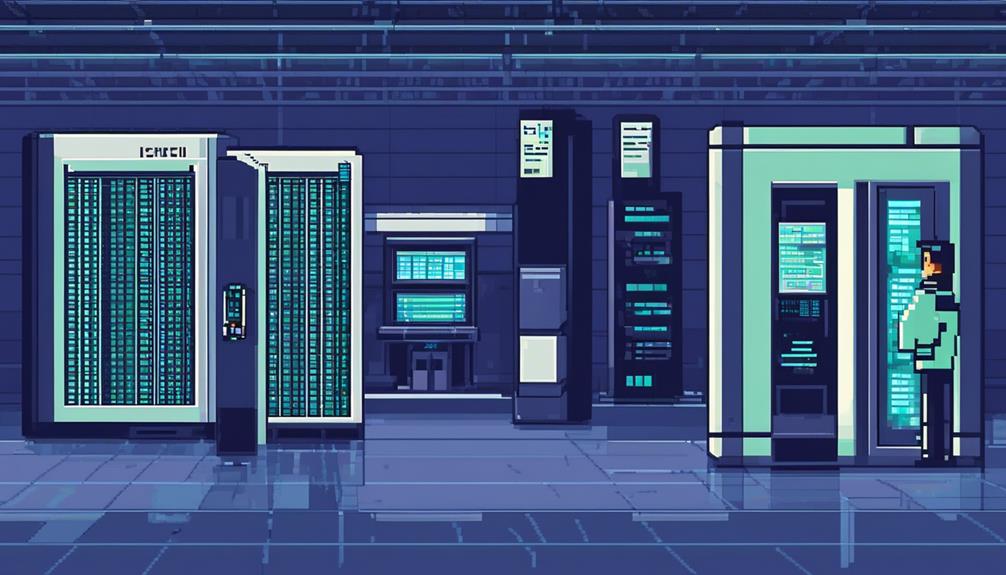
Access control systems play a crucial role in data center security. They limit and manage entry to specific areas. These systems employ various methods such as keycards, biometric scanners, or PIN codes to authenticate and grant access to authorized personnel.
Types of Access Control
Access control systems are essential components of data center security, allowing for the safeguarding of sensitive information through a combination of physical, logical, and administrative measures. These systems provide a layered approach to protect data centers from unauthorized access and potential breaches.
- Physical access control: Measures such as biometric scanners, key cards, and security guards are employed to limit entry to data center facilities. These security features ensure that only authorized personnel can access the physical data storage areas.
- Logical access control: Authentication and authorization processes are implemented to restrict user access to data and systems based on permissions. This ensures that only authorized individuals can access and manipulate data within the data center.
- Administrative access control: Policies and procedures govern the management of user accounts, privileges, and access rights. This ensures that access to sensitive data is granted only to authorized personnel, minimizing the risk of unauthorized access.
Importance of Access Control
Crucial for ensuring data center security, access control systems limit user privileges and permissions while preventing unauthorized access to sensitive data and infrastructure. These systems play a significant role in safeguarding the reputation and trust of an organization by controlling and monitoring user access. Access control systems also help organizations comply with data protection regulations, reducing the risk of financial losses and legal liabilities associated with data breaches and unauthorized access. To enhance data center security, access control systems can be integrated with physical security measures such as cabinet locking mechanisms and security features. By implementing access control systems, organizations can effectively protect their data center infrastructure and mitigate the potential risks posed by unauthorized individuals.
| Benefits of Access Control Systems |
|---|
| Limit user privileges and permissions |
| Prevent unauthorized access to sensitive data and infrastructure |
| Ensure compliance with data protection regulations |
| Safeguard the reputation and trust of the organization |
| Reduce financial losses and legal liabilities associated with data breaches |
Surveillance Cameras
Surveillance cameras in data centers provide visual monitoring and recording of activities, ensuring the maintenance of physical security and adherence to compliance standards. These cameras are an essential component of data center physical security, working in conjunction with security guards and access control systems to protect critical infrastructure.
The presence of surveillance cameras evokes a sense of safety and reassurance. Knowing that their every move is being monitored by video surveillance, potential intruders are deterred from attempting unauthorized access. This gives data center operators peace of mind, knowing that their facility is being actively monitored and protected.
Furthermore, surveillance cameras enhance incident response and investigation processes. In the event of a security breach or suspicious activity, the footage captured by these cameras can provide valuable evidence for identifying the perpetrators and understanding the sequence of events. This aids in both internal investigations and potential legal proceedings, ensuring that appropriate actions can be taken to prevent future incidents.
In addition to physical security benefits, surveillance cameras also contribute to compliance standards. Many industry regulations require data centers to have robust monitoring systems in place, and video surveillance is a key component of these requirements. By having surveillance cameras installed and operational, data center operators can demonstrate their commitment to maintaining a secure and compliant environment.
Biometric Authentication
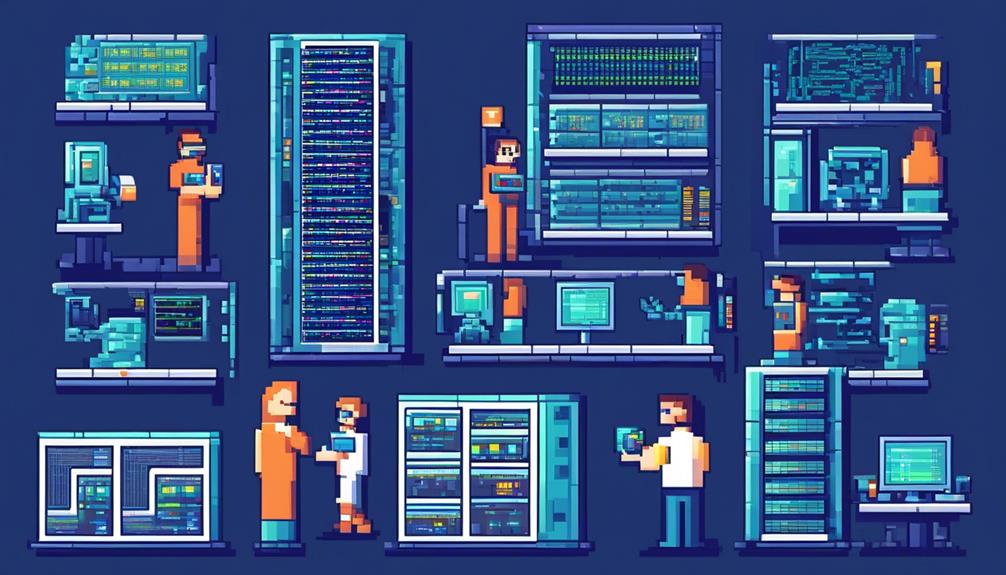
Biometric authentication is a highly secure method of verifying a user's identity by utilizing unique biological traits such as fingerprints, facial recognition, or iris scans. In the context of data center security, physical centers that house critical information and infrastructure, the need for robust security measures is paramount.
Data centers need advanced cabinet locking mechanisms and security features to ensure that only authorized personnel can access sensitive areas.
Biometric authentication offers a reliable and efficient solution for data center security. By leveraging an individual's unique biological traits, it becomes extremely difficult for unauthorized users to replicate or fake someone's biometric data. This eliminates the vulnerabilities associated with passwords or access cards, reducing the risk of unauthorized access due to stolen or shared credentials.
Implementing biometric authentication in data centers provides several benefits. Firstly, it offers a convenient way for authorized users to access secure areas or systems without the need to remember or carry physical tokens. This streamlines the authentication process and improves operational efficiency.
Secondly, biometric authentication can be integrated with other security measures, such as surveillance cameras and intrusion detection systems, to provide multi-factor authentication. This enhances overall data center security by adding an additional layer of protection.
Data center operators should carefully consider the selection and implementation of biometric authentication systems. Factors such as accuracy, reliability, scalability, and compatibility with existing infrastructure should be taken into account. Additionally, privacy concerns and regulatory requirements should be addressed to ensure compliance.
Security Alarms
Security alarms play a vital role in ensuring the physical security and integrity of data centers by providing real-time alerts for unauthorized access and potential security breaches. These alarms act as a proactive measure to safeguard valuable data and protect against potential threats.
Here are two important aspects of security alarms that highlight their significance in data center security:
- Integration with Access Control Systems and Surveillance Cameras:
- When security alarms are integrated with access control systems, it enhances the overall physical security of the data center. This integration allows for seamless monitoring and control of access points, ensuring that only authorized personnel can enter restricted areas.
- By integrating security alarms with surveillance cameras, data center operators can have a comprehensive view of the facility. This combination enables real-time monitoring and recording of potential security breaches, providing valuable evidence for investigations and deterrence against unauthorized activities.
- Monitoring Environmental Conditions:
- Security alarms are not limited to detecting unauthorized access; they can also monitor environmental conditions within the data center. This includes parameters such as temperature, humidity, and water leakage.
- By constantly monitoring these environmental factors, security alarms help maintain optimal conditions for the data center's infrastructure. Any deviation from the predefined thresholds can trigger immediate alerts, allowing for timely action to mitigate potential damage and protect the integrity of the data stored within the center.
Encryption Hardware
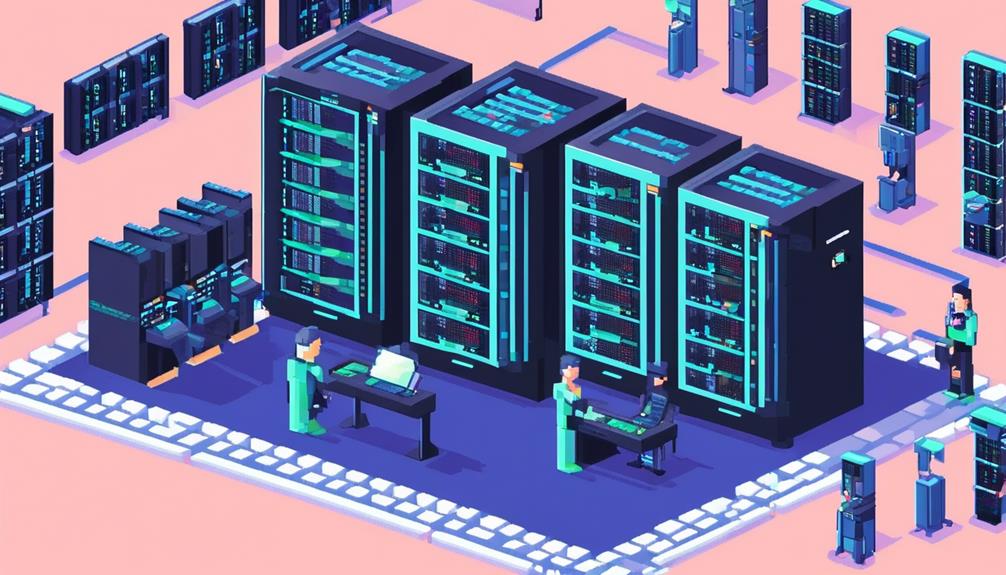
Integration of security alarms with access control systems and surveillance cameras is just one aspect of ensuring data center security.
Another crucial component is encryption hardware, which provides dedicated processing for encrypting and decrypting data, offering an additional layer of protection beyond software-based encryption. Encryption hardware is essential for securing critical applications and data, safeguarding sensitive information from unauthorized access both at rest and in transit.
Data centers house a vast amount of valuable and sensitive data, making them prime targets for cyber attacks. Encryption hardware plays a vital role in protecting this data by providing secure data storage and transmission. It ensures that even if an attacker gains physical or logical access to the storage devices inside the data center, the data remains encrypted and inaccessible without the proper decryption keys.
Encryption hardware operates independently and accelerates cryptographic operations, minimizing the impact on system performance. It offers high-speed encryption and decryption capabilities, ensuring efficient and secure data processing. This is especially important in data centers, where large volumes of data are constantly being processed.
Moreover, encryption hardware can support various encryption algorithms and key management functionalities, allowing organizations to tailor their security measures to meet specific requirements. It provides the flexibility to implement industry-standard encryption protocols and comply with regulatory standards.
In addition to encrypting data, encryption hardware often incorporates other security features to protect against unauthorized access, such as tamper-evident designs and secure key storage. These redundant capacity components further enhance the overall security posture of the data center.
Physical Barrier Systems
Physical barrier systems are essential components of data center security, providing secure locations and limited entry points to prevent unauthorized access. These systems incorporate multiple layers of security hardware to protect data and hardware from interference, theft, and corruption within data centers.
Here are some key features of physical barrier systems:
- Secure Locations:
- Data centers are equipped with fortified walls, fences, and gates to create secure perimeters and deter unauthorized entry.
- Access to sensitive areas within the data center is restricted to authorized personnel only, ensuring that only authorized individuals can access critical infrastructure.
- Cabinet locking mechanisms are used to secure servers and equipment, preventing physical tampering and theft.
- Limited Entry Points:
- Data centers have controlled entry points with access control systems, such as card readers or biometric scanners, to authenticate individuals before granting them access.
- Video surveillance is employed to monitor and record activities at entry points, ensuring that any suspicious behavior is detected and responded to promptly.
Frequently Asked Questions
What Hardware Is Used in Data Centers?
In the realm of data centers, various hardware components play a crucial role in supporting the network infrastructure. These include:
- Routers
- Switches
- Storage systems
- Server racks
- Cooling systems
- Power distribution units
- Fire suppression mechanisms
Access control solutions are also employed to ensure secure entry points. By encompassing these elements, data centers can effectively manage and protect their computing and storage resources. This guarantees a secure and efficient environment for data processing and storage.
How Would You Secure a Data Center?
Best practices for data center security include implementing robust access control measures, such as biometric readers and multifactor authentication, to ensure only authorized personnel can enter sensitive areas.
Surveillance systems, including CCTV cameras and motion sensors, play a crucial role in monitoring and deterring unauthorized access.
Fire suppression systems, such as sprinklers and fire alarms, are important for protecting data center infrastructure from fire-related incidents.
Securing data center networks against cyber threats involves using firewalls, intrusion detection systems, and encryption.
Employee training is also essential to educate staff about security protocols and potential risks.
What Are Some of the Physical Security a Data Center Should Have?
A data center should have robust physical security measures in place to protect its sensitive information. These measures include:
- Access control systems to restrict entry to authorized personnel
- Video surveillance to monitor and record activities within the facility
- Intrusion detection systems to quickly identify and respond to any unauthorized access attempts
- Environmental monitoring to ensure optimal conditions for equipment
- Fire suppression systems to mitigate the risk of fire
- Backup power systems to maintain continuous operations in the event of power outages
These measures collectively help safeguard the data center from potential threats and ensure its uninterrupted functioning.
What Are the 3 Main Components of a Data Center Infrastructure?
In a data center infrastructure, the three main components are computing resources, storage resources, and networking resources.
Computing resources include servers, application-delivery controllers, and virtualization platforms.
Storage resources encompass storage systems, backup solutions, and data replication technologies.
Networking resources consist of routers, switches, firewalls, load balancers, and network security appliances.
These components work together to ensure efficient data center operations.
Additionally, data center cooling systems, power supply, network infrastructure, redundancy, storage solutions, and management software play crucial roles in maintaining the functionality and reliability of a data center.
